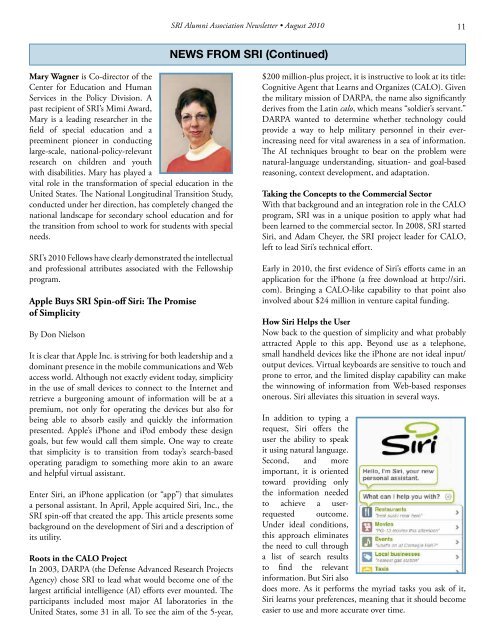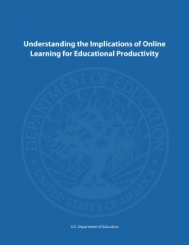Aug 2010 - SRI International
Aug 2010 - SRI International
Aug 2010 - SRI International
Create successful ePaper yourself
Turn your PDF publications into a flip-book with our unique Google optimized e-Paper software.
<strong>SRI</strong> Alumni Association Newsletter • <strong>Aug</strong>ust <strong>2010</strong><br />
11<br />
NEWS FROM <strong>SRI</strong> (Continued)<br />
Mary Wagner is Co-director of the<br />
Center for Education and Human<br />
Services in the Policy Division. A<br />
past recipient of <strong>SRI</strong>’s Mimi Award,<br />
Mary is a leading researcher in the<br />
field of special education and a<br />
preeminent pioneer in conducting<br />
large-scale, national-policy-relevant<br />
research on children and youth<br />
with disabilities. Mary has played a<br />
vital role in the transformation of special education in the<br />
United States. The National Longitudinal Transition Study,<br />
conducted under her direction, has completely changed the<br />
national landscape for secondary school education and for<br />
the transition from school to work for students with special<br />
needs.<br />
<strong>SRI</strong>’s <strong>2010</strong> Fellows have clearly demonstrated the intellectual<br />
and professional attributes associated with the Fellowship<br />
program.<br />
Apple Buys <strong>SRI</strong> Spin-off Siri: The Promise<br />
of Simplicity<br />
By Don Nielson<br />
It is clear that Apple Inc. is striving for both leadership and a<br />
dominant presence in the mobile communications and Web<br />
access world. Although not exactly evident today, simplicity<br />
in the use of small devices to connect to the Internet and<br />
retrieve a burgeoning amount of information will be at a<br />
premium, not only for operating the devices but also for<br />
being able to absorb easily and quickly the information<br />
presented. Apple’s iPhone and iPod embody these design<br />
goals, but few would call them simple. One way to create<br />
that simplicity is to transition from today’s search-based<br />
operating paradigm to something more akin to an aware<br />
and helpful virtual assistant.<br />
Enter Siri, an iPhone application (or “app”) that simulates<br />
a personal assistant. In April, Apple acquired Siri, Inc., the<br />
<strong>SRI</strong> spin-off that created the app. This article presents some<br />
background on the development of Siri and a description of<br />
its utility.<br />
Roots in the CALO Project<br />
In 2003, DARPA (the Defense Advanced Research Projects<br />
Agency) chose <strong>SRI</strong> to lead what would become one of the<br />
largest artificial intelligence (AI) efforts ever mounted. The<br />
participants included most major AI laboratories in the<br />
United States, some 31 in all. To see the aim of the 5-year,<br />
$200 million-plus project, it is instructive to look at its title:<br />
Cognitive Agent that Learns and Organizes (CALO). Given<br />
the military mission of DARPA, the name also significantly<br />
derives from the Latin calo, which means “soldier’s servant.”<br />
DARPA wanted to determine whether technology could<br />
provide a way to help military personnel in their everincreasing<br />
need for vital awareness in a sea of information.<br />
The AI techniques brought to bear on the problem were<br />
natural-language understanding, situation- and goal-based<br />
reasoning, context development, and adaptation.<br />
Taking the Concepts to the Commercial Sector<br />
With that background and an integration role in the CALO<br />
program, <strong>SRI</strong> was in a unique position to apply what had<br />
been learned to the commercial sector. In 2008, <strong>SRI</strong> started<br />
Siri, and Adam Cheyer, the <strong>SRI</strong> project leader for CALO,<br />
left to lead Siri’s technical effort.<br />
Early in <strong>2010</strong>, the first evidence of Siri’s efforts came in an<br />
application for the iPhone (a free download at http://siri.<br />
com). Bringing a CALO-like capability to that point also<br />
involved about $24 million in venture capital funding.<br />
How Siri Helps the User<br />
Now back to the question of simplicity and what probably<br />
attracted Apple to this app. Beyond use as a telephone,<br />
small handheld devices like the iPhone are not ideal input/<br />
output devices. Virtual keyboards are sensitive to touch and<br />
prone to error, and the limited display capability can make<br />
the winnowing of information from Web-based responses<br />
onerous. Siri alleviates this situation in several ways.<br />
In addition to typing a<br />
request, Siri offers the<br />
user the ability to speak<br />
it using natural language.<br />
Second, and more<br />
important, it is oriented<br />
toward providing only<br />
the information needed<br />
to achieve a userrequested<br />
outcome.<br />
Under ideal conditions,<br />
this approach eliminates<br />
the need to cull through<br />
a list of search results<br />
to find the relevant<br />
information. But Siri also<br />
does more. As it performs the myriad tasks you ask of it,<br />
Siri learns your preferences, meaning that it should become<br />
easier to use and more accurate over time.
















